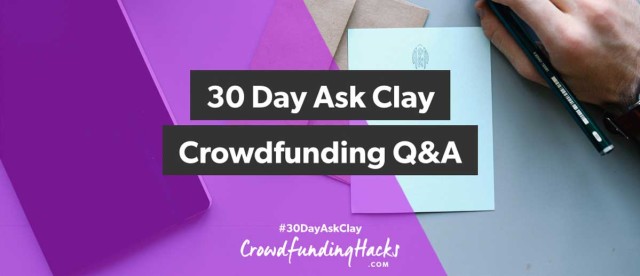This is the second post in our 30 Day Ask Clay Crowdfunding Q&A.
I’m answering a new question every day in June.
Submit your question by going to CrowdfundingHacks.com/AskClay, where you can see all of the questions and all of my answers.
Full Transcript
Hey everyone…this is Clay Hebert from CrowdfundingHacks.com…and today’s question is…
What are the different types of crowdfunding?
This is an important question because the four different types of crowdfunding all get lumped under this umbrella term of crowdfunding, but they’re actually very different.
This is also an important question, because the rest of this series focuses almost completely on one of those types of crowdfunding.
Depending on where you look online, you’ll see different answers and sometimes different terms, but the way I break it down, there are four distinct types of crowdfunding.
- Rewards-based crowdfunding
- Donation-based crowdfunding
- Equity crowdfunding
- Debt crowdfunding
Let’s look at each one in a little more detail.
1. Rewards-based crowdfunding
In rewards-based crowdfunding, backers contribute typically small amounts of money (typically between $1 and $1,000 but sometimes more) in exchange for a reward. This reward is often, but not always, the item being produced, such as a watch, an album or a film.
Kickstarter and Indiegogo are the two most popular rewards-based crowdfunding platforms but there are LOTS of other platforms.
While some of the tips and strategies apply to other forms of crowdfunding, this series focuses almost completely on rewards-based crowdfunding.
2. Donation-based crowdfunding
In donation-based crowdfunding, donors generally donate small amounts (again, typically between $1 and $1,000, but sometimes more).
Like the name suggests, in a lot of donation-based crowdfunding, there isn’t always a reward beyond the gratitude of the project creator or beneficiary (and possibly a tax deduction). Donation-based crowdfunding is typically used to raise money for a non-profit or a cause, like drilling a well or building a school in Africa or for a personal campaign like an individual’s treatment or medical bills.
GoFundMe and Crowdrise are two popular donation-based crowdfunding platforms but there are lots of others. You can also do donation-based crowdfunding on Indiegogo and even Kickstarter but you have to be within each platforms guidelines. For instance, on Kickstarter you can’t promise to donate funds raised to a charity or cause.
3. Equity crowdfunding
In equity-crowdfunding, investors give larger amounts of money (at least $1,000 and often a lot more). When investors give the money, they don’t get a reward, but instead, a small piece of equity in the company itself.
As a result, equity crowdfunding is typically used to raise money to fund the launch or growth of a company, not just initiate a creative project or cause. Often, these companies go on to raise money from angel investors or venture capitalists.
AngelList and Crowdfunder are two of the most popular equity-crowdfunding platforms in the United States, but there are lots of others. Fundable, EarlyShares and CircleUp are other popular platforms in the U.S. and and Crowdcube and Seedrs are popular in the U.K. and Europe.
There are actually three different kinds of equity crowdfunding, there are specific terms and regulations. Basically it gets more complicated, but this series is focused on reward-based crowdfunding, so we’re not going to go into all of that here.
And last but not least…
4. Debt crowdfunding
In debt-crowdfunding, it’s not “backers” or “donors” who give money, but lenders (sometimes these lenders are called investors).
Unlike other forms of crowdfunding, it’s NOT an exchange for a reward or equity. The investors don’t get a reward and they don’t get a piece of equity in the company, but instead they make a loan with the expectation to get paid back the principal plus interest.
So it’s a lot like loan from the bank, but instead of borrowing one larger amount of money from one bank, you borrow smaller amounts of money from multiple people.
Debt-crowdfunding can be used to raise money for lots of reasons, like credit card refinancing, debt consolidation, home improvement, a car or other reasons.
So to recap…
- In rewards-based crowdfunding, backers give a small amount of money in exchange for a reward.
- In donation-based crowdfunding, donors donate a small amount of money in exchange for gratitude and the feeling of supporting a cause they believe in.
- In equity crowdfunding, investors invest large amounts of money in a company in exchange for a small piece of equity in the company.
- And in debt crowdfunding, lenders make a loan with the expectation to make back their principal plus interest.
Those are the four types of crowdfunding.
You can submit your question for the series or see all of the questions and my answers at http://crowdfundinghacks.com/AskClay
